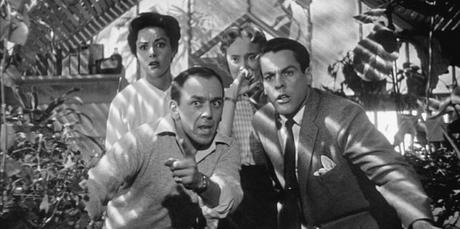 Becky (Dana Wynter), Jack (King Donovan), Teddy (Carolyn Jones) & Miles (Kevin McCarthy) are speechless in Don Siegel’s Invasion of the Body Snatchers (1956)
Becky (Dana Wynter), Jack (King Donovan), Teddy (Carolyn Jones) & Miles (Kevin McCarthy) are speechless in Don Siegel’s Invasion of the Body Snatchers (1956)What if you went to bed one night with your significant other and woke up the next morning to find that he or she wasn’t exactly the same.
Oh, they may look like the same individual, all right. They even talk, walk, dress, feel, and act like your beloved spouse or relative. But there’s something different about them, something you noticed in their eyes. To coin a phrase from a well-known popular song, they’ve lost that “lovin’ feelin’,” that certain gleam, that emotional spark, that intimate connection to you and to past events that tell you your Uncle Joe or Aunt Sarah isn’t the man or woman you thought they were.
The horror and science-fiction genre is privy to all sorts of “what-if” scenarios such as these. The films of the 1950s were especially prone to invasion theories, of “little green men” plotting to take over the universe for reasons known only to them. RKO’s The Thing from Another World (1951) told of one such intruder, an advance scout that turned out to be a blood-sucking “intellectual carrot” with super-human strength and a will to survive at all costs.
In Twentieth Century-Fox’s The Day the Earth Stood Still (also 1951), there were no space invaders as such but rather an amiable, cultivated emissary from another planet (played by an equally refined British actor). He wasn’t out to destroy humanity (at least, not yet) but to understand it. In case of trouble, however, this emissary relied on an eight-foot-tall robotic companion — an interplanetary armed guard, if you prefer — to ward off the authorities.
Taking this analogy a step or two further, the one-eyed gelatinous beings of Universal-International’s It Came from Outer Space (1953) were neither conquerors nor destroyers but explorers from a highly-evolved civilization that accidentally crash-land on Earth. Despite their loathsome visage, the aliens’ motives are benign in that they need humanity to help repair their damaged spacecraft so they could return to their peaceful mission.
From the same year, Paramount Pictures released The War of the Worlds, an updated version of H.G. Wells’ Victorian-era novel about those proverbial little green men from Mars. The film took the opposite tack, in that sheer firepower and coordinated attacks, along with a brutal frontline assault, would culminate in total victory. Ah, but those annoying creatures never reckoned with the tiniest of God’s creations: the multitudinous germs and bacteria that inhabit every corner of our planet. Where atomic weapons proved futile in repelling the invaders, infectious disease took over and decimated the Martian’s plans for world domination.
But there were subtler, more insidious methods of conquest yet to be explored. For example, what if you could merge the “alien invasion” picture with a more restrained, less blatant approach — in other words, the humans you are trying to take over would never know they were being taken over?
This is the premise for one of the most chilling, most hallucinatory features to have come along in many a decade: producer Walter Wanger and director Don Siegel’s Invasion of the Body Snatchers from 1956, distributed by Allied Artists Pictures.
The story, adapted from Jack Finney’s 1954 novel The Body Snatchers, involves an alien life form that assumes the innocuous shape of seeds. What’s so terrible about that? Nothing at all, really — until those same outer-space seeds plant themselves in a farmer’s field somewhere in Southern California. From there, the seeds grow into giant pods that slowly and sinisterly take over the minds and bodies of whoever happens to be around. Once the victims fall asleep, the “pod people” complete their transformation and dispose of the original body.
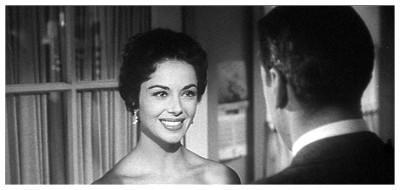
Such a preposterous idea could have easily been turned into a campy, low-budget frolic with schlocky special effects and over-the-top performances. In the hands of the gifted Don Siegel, however, Invasion of the Body Snatchers became a bona-fide classic of the sci-fi/body horror genre.
The setting is a sleepy fictionalized town known as Santa Mira. One of its inhabitants, Dr. Miles Bennell (lantern-jawed Kevin McCarthy), is a general practitioner just returned from a medical convention. His nurse, Sally Withers (Jean Willes), greets him at the train station to convey the news that the town is in the grip of a mass hysteria. Miles’ office is full of patients who demand to see him and only him. Upon further inquiry, Miles is informed that various individuals have reported that the person they live with, or confide in on a regular basis, is not that person.
After a day of this, the anxious patients have all cancelled their appointments and the crisis (whatever it was) appears to have been averted. Once Miles gets settled in, he reconnects with lost love Becky Driscoll (winsome Dana Wynter), fresh from a trip to Reno for a quickie divorce. Becky calls on Miles in his office to report that her cousin Wilma (Virginia Christine) swears up and down that her dear old Uncle Ira (Tom Fadden) isn’t Uncle Ira.
A quick stop at Wilma’s place and a talk with Uncle Ira does little to alleviate her concerns. Still, Miles manages to convince Wilma to see a psychiatrist friend of his, Dr. Dan Kauffman (Larry Gates). It’s possible, in Dan’s later clear-eyed appraisal, that the stresses of modern life may have forced the townspeople to escape from reality. Hmm…
While Becky and Miles go off to rekindle their former relationship, they each take notice of peculiar departures from Santa Mira’s normal routine. For instance, that evening the couple goes out to dine at their favorite dance hall and restaurant. But instead of a crowded gathering, the establishment is empty except for the maître d’.
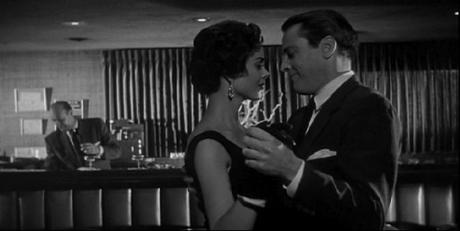
Earlier on, Miles and Nurse Sally drive by an abandoned vegetable stand. The month before, “it was the cleanest and busiest stand on the road,” but now it was boarded up and littered with debris.
There are similar lines of dialog spoken throughout the picture, minor references and random, off-the-cuff observations that elucidate the plot for viewers in subtle, indirect ways. Taken as a whole, when you’ve re-watched the film (as this author has) after so many years of neglect, you begin to notice, as the characters themselves do, that something is terribly out of kilter from the start.
More samples of what we are driving at: Becky Driscoll’s entry into the story via her spur-of-the-moment visit to Miles’ office. She’s been living in England for the past few years. “It’s wonderful to be home again,” she confides to him, but quickly adds, “I’ve been away so long …. I feel almost like a stranger in my own country.” She’s not joking.
Then there’s little Jimmy Grimaldi, who thinks his mother isn’t really his mother. Miles gives him a sedative, a pill to drive away the demons from his mind. “Open your mouth. Shut your eyes,” he orders. “In the words of the poet … I’ll give you something to make you wise.” Make him “wise”? Not exactly, but certainly more complacent — a metaphor for what will happen in time to the town’s population as a whole.
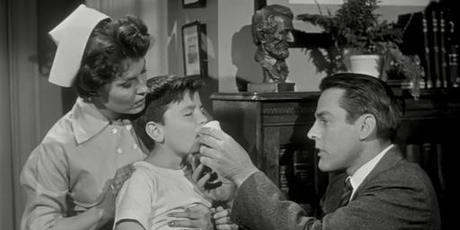
At roughly 80 minutes, Invasion of the Body Snatchers is a taut little film, with nary a wasted moment or superfluous occurrence anywhere. Everything is held together (and remains that way) thanks to a tidy screenplay by veteran mystery and film-noir writer Daniel Mainwaring (Out of the Past, The Big Steal). There are noticeable noir strictures to be followed, including the perfunctory narration (by Kevin McCarthy), the ominous black-and-white cinematography (courtesy of Ellsworth Fredericks), the crisply-edited footage (Robert S. Eisen), and the creepy musical score (by Carmen Dragon).
And true to the genre itself, Miles and Becky tease each other good-naturedly with quips and innuendos about marriage and divorce. They also reminisce about being back together:
“I wish you didn’t have to go home for dinner,” Miles states emphatically.
“I don’t,” Becky counters. “Dad’s eating out with a friend.”
“I could pick you up at seven,” Miles hints to her.
“Well … It’s summer, and the moon is full. ‘I know a bank …’”
“… ‘Where the wild thyme grows’,” Miles completes the phrase, and then adds, “You haven’t changed a bit.”
Not yet she hasn’t.
That line about “the moon is full” is an obvious allusion to werewolves, who convert to vicious fiends once the moon is out. It’s a none-too-subtle clue of the horror to come, except there are no rapacious night creatures, only deadly dull, emotionless carbon copies of former loved ones.
Miles and Becky meet up with Dan Kauffman, the resident analyst, who comments on the epidemic of mass hysteria that has taken hold of Santa Mira. He’s got a full plate on his hands. Kauffman is that person of stature who appears in all these science-fiction flicks of the Fifties, the one individual whose sole function is to explain to the audience what the heck is going on.
Hardly satisfied with Dan’s rationale, Miles takes Becky home. It is evening and the lights are out. In silhouette, Becky muses on the strangeness of what’s been happening to her town.
“Let’s hope we don’t catch it,” Miles jokes in response. But in mock serious tones, he discloses, “I’d hate to wake up some morning and find out you weren’t you.” Prophetic words, indeed!
Towards the end, Miles and Becky are treated as fugitives from justice (another film-noir conceit) in their attempts to get away from the encroaching mob of pod people out to prevent the couple from alerting the outside world to their presence. Panic, paranoia, and suspicion cloud Miles’ judgment, as they do Becky’s and their friends, Jack (King Donovan) and Teddy Belicec (Carolyn Jones). No one can be trusted: it’s neighbor against neighbor, and relative against relative, until eventually the entirety of Santa Mira has been taken over by alien pods.
One of the scariest sequences occurs in Jack’s home, where he and wife Teddy, along with Miles and Becky, witness the pods’ transformation into lifelike replicas of (gasp!) themselves. It’s a genuinely unsettling moment: before their eyes, the lineless facial features and bubbling torsos begin to form and take shape. Destroying the bodies with a pitchfork and setting them all on fire, Miles tries to alert the FBI, but is thwarted when he realizes the phone offices have been usurped by the pod people, as have the police department and everyplace else. The friends then flee for their lives but vow to meet up again in town.

Escaping to his medical office (a place that’s supposed to cure people of whatever it is that ails them), Miles and Becky hide out there temporarily, awaiting Jack’s return. They go down a long and narrow corridor, which heightens the feeling of claustrophobia. The walls are closing in around them — and fast. Prior to this, their attempt to enlist Sally in their cause backfires when Miles sees her take one of the seedpods up to her baby’s bedroom. The chase is on, as the police issue an all-points-bulletin to apprehend and detain the couple.
A comparable scene takes place near the end, where Becky and Miles are seeking shelter in a cave near the outskirts of town. They hide from their pursuers in an old mineshaft, placing wooden floorboards on top as they squish inside an empty hole in the ground. It’s tantamount to a gravesite, of being in one’s coffin or burial plot. While the mob runs over them, completely unmindful of where they’re hidden, the lovers cower just below the pursuers’ feet. It’s a real nail-biter of a sequence.
We, the viewer, can feel their unease, since the camera has followed the couple inside that dark, damp hole. But it only provides a temporary shelter. The sense of eeriness about this episode is elevated tenfold by the skewed camera angles and the intensity of the footsteps. When they’re finally alone, they leave the hole. Miles and Becky may have risen to new life as purposeless ciphers or reached the end of the line. Which is it?
Hints as to what’s in store for our heroes abound throughout the story. When later cousin Wilma encounters Miles in the street, she tells him she no longer needs a shrink. “I woke up this morning, and everything was all right.” She goes back inside her store and flips the sign on the door from “Open” to “Closed” — permanently, I’d venture to say. There’ll be no more need for work. No more ambition, no more striving to better oneself. No practicing of one’s profession, no call for one’s betterment or personal fulfillment. Existence is its own reward, and the pursuit of happiness can be stricken from one’s vocabulary.
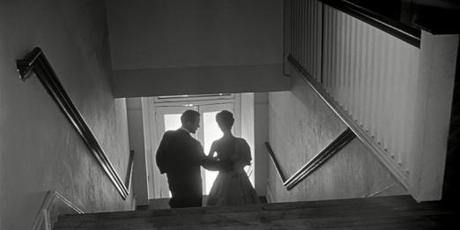
Released in the 2.00:1 aspect ratio (in this instance, called Superscope), Invasion of the Body Snatchers was originally conceived by director Siegel to be in the standard 1.33:1 ratio. But the distributor, Allied Artists, insisted on the wide screen size, possibly to attract movie audiences used to CinemaScope, VistaVision, and other such formats.
Allied Artists also requested that Siegel provide an expository prologue and epilogue to the production. Both Siegel and producer Wanger argued in favor of keeping things the way they were, with nothing bookending the completed film. However, they lost the argument and a quickie prologue and epilogue were added. These were set inside a hospital emergency ward, where a supposedly “insane” Miles Bennell is confronted by the attending physician (Richard Deacon) and the hospital’s skeptical shrink (Whit Bissell). Consequently, the tale is told in flashback from here on.
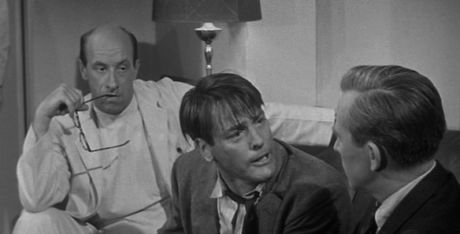
Either way you slice it, the film works on many levels — with or without those appended sequences. While there is no “happy ending” as such, most viewers have come away with the hopeful conclusion that maybe — just maybe — the invasion can be foiled. And that somehow, the long-suffering Miles will at last be vindicated.
The long-held notion that Invasion of the Body Snatchers was a cautionary tale against Communist encroachment, i.e. the so-called Red Scare menace, has not always held up over time. Sure, the U.S. had undergone years of House Un-American Activities Committee hearings, along with the ensuing witch hunts, and accusatory fingers pointed at the movie industry. Once the McCarthy hearings had blown over, however, the dust settled to reveal that Siegel had not explicitly set out to capture those sentiments in his film, at least not overtly.
While not part of the director’s original concept, the themes of conformity and uniformity in 1950s American life can be viewed as relevant to the main issue. Nowadays, diversity and multiculturalism are the “buzz words” that tend to dominate the conversation, although you would never know it by our highly-charged and exceedingly politicized atmosphere. That the film has resonance to our day is proof enough of its status as a timeless classic.
Here are some things to look for on your next viewing of this archetypal sci-fi flick: pay close attention to the shadows and darkness that slowly engulf the town; make note of the studied calmness of the so-called pod people; take notice of background noises in the basement; and look quickly for Charlie, the meter reader, played by future director Sam Peckinpah in a bit part.
More importantly, make yourself aware that the closer Miles and Becky get to one another as a loving couple, the farther apart they will seem relative to their “inhuman” counterparts. As at the beginning of the drama, everything appears to be normal and humdrum; people continue about their business except when the delivery trucks ride into town to deliver more seedpods to all comers. Notice how quickly they disseminate the pods to every town and village within the Los Angeles vicinity, and within a relatively short time. That’s chaos theory in action!
Remember, too, Miles’ look of utter despair — his expression of absolute shock and bewilderment at the realization that his beloved is now one of “them.” His earlier warning about waking up one day to find that Becky is no longer Becky come back to haunt him in one of those rare cinematic moments of discovery, an indelible scene that’s sure to send shivers down your spine. There is nothing left for poor Miles to do but run away, right out onto the highway, to inform others of the nightmare that awaits them in sleepy Santa Mira.
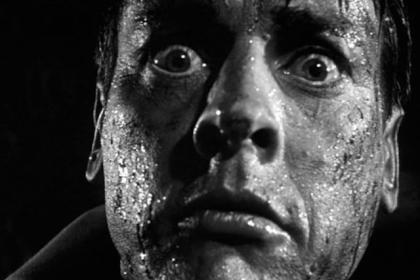
When last we see him, Miles stands in the middle of oncoming traffic, spouting the words of a crazed mystic, a male Cassandra that nobody listens to: “You fools! You’re in danger! Can’t you see? They’re after you! They’re after all of us! Our wives, our children, everyone! They’re here already! You’re next! You’re next! You’re next …”
This is straight out of the school of nihilistic thought. Aren’t you glad we warned you?
Copyright © 2017 by Josmar F. Lopes
Advertisements
